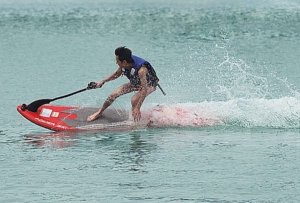
Sailing can be a quiet leisurely way to spend a day, or a fast paced, high action adventure; and sometimes both in one day should the weather turn quickly. Sailing provides a great opportunity for children to practice co-operation and teamwork in an exciting setting, but their presence also requires captains to run an especially tight ship. Teaching children safe sailing from day one and setting a good example every time is key to turning kids into sailors.
Why sailing can be risky for children and youth
There are many danger spots on a sail boat, and it takes experience to know how to avoid them. The two primary causes of sailing fatalities are being swept overboard while not wearing a PFD and being struck in the head by the boom when it swings. Young children have longer reaction times than adults and can not process a call out to “duck” as quickly, so special precautions will have to be taken every time the boom is swung.
Falls into open hatches and slips on deck are also common hazards for children. Most sailing injuries occur to the hands and to the head. Severe finger and hand injuries are often caused by improper use of the winches and cleats.
Before embarking, all crew and passengers should discuss rules and safety guidelines, including who will take on what tasks should a person go overboard or in the event of a capsize. Children should be addressed directly regarding safe and unsafe areas of the boat, where and when they should remain seated, what roles and tasks they can perform, and what the biggest hazards are.
Keeping children busy on a boat will help keep them safe. Young children can practice knots on extra rope or be put on the lookout for buoys, ships, or land. Older children can be taught how to man the VHF radio, read navigational charts, wash the decks or hold the boat on course. It is also important that safety precautions apply to a docked boat as well; accidents are just as likely to occur then, especially if adults take a more casual approach when docked.
Young children should not move about
freely on a sailboat in motion
Recommendations for sailing with children
● Use of a personal flotation device should be required for children and youth regardless of swimming skills. It is also recommended that adults wear a PFD.
● Children old enough to assist with the ropes should initially be trained and supervised in order to prevent entanglement or burns and abrasions to hands and fingers.
● When sailing with children, have at least 3 adults on board, 2 to man the boat and 1 to perform a rescue if needed.
● Children must be instructed to never jump off the boat for a swim when docked due to the danger of objects beneath the surface.
● Children must have previous experience swimming and treading water in open water.
● All children and passengers should be aware of the location of the propeller and the danger it presents.
● Adults should follow the rules themselves to set a good example.
● Adults should not drink alcohol before or while boating.
What safety factors to look for in choosing and maintaining equipment?
High toe rails will help keep children and objects on board, and safety netting is recommended if young children will be on board. Low grab rails are helpful, and the use of short harnesses and life lines can come in handy, although young children should still never be left unsupervised.
Staff Preparedness
● Be sure that your staff members are trained in CPR and first aid.
● Children will need individual assistance exiting and boarding the boat.
● When leading a tour that includes several children and youth, try to assign an adult buddy to each child and have an extra staff member on hand.
● Besides the normal safety provisions onboard any boat, a boat carrying children should have extra first aid basics and child dosage medications for illnesses such as motion sickness, vomiting and fevers.
● All staff members should be able to clearly communicate the risks and safety rules to clients. A language barrier could pose a problem should an accident occur, both in terms of immediate medical care, and liability for having failed to properly communicate the rules.
● Staff should very regularly check reliable sources regarding wind and water conditions. .
*Source : European Child Safety Alliance, Eurosafe; 2008.- With the support of the European Commission













